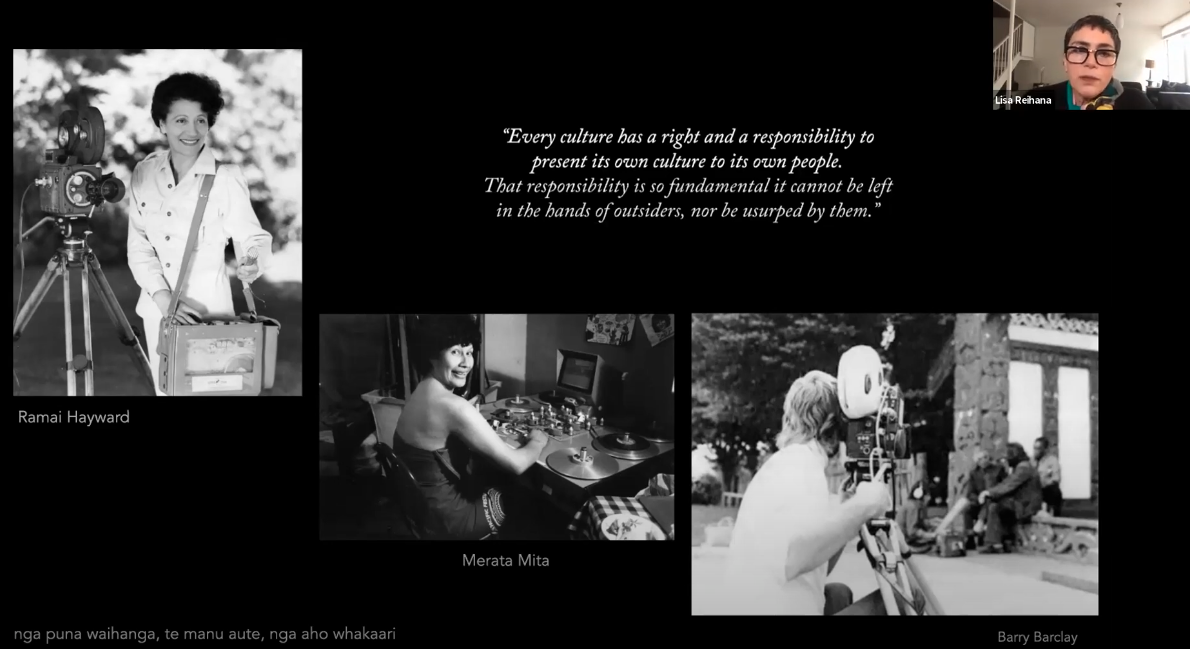ATC Revisited: Lisa Reihana

Lisa Reihana spoke on Monday, September 13, 2021 at the Art, Technology, and Culture Colloquium at BCNM. Recap from ATC Liaison Jaclyn Tobia.
We had the honor of hosting multidisciplinary artist Lisa Reihana for her lecture entitled "How Can a Māori Girl Recolonise the Screen Using Mighty Pixels" last Monday. It was a fabulous kick off as our first ATC/Indigenous Technologies lecture of the year, cosponsored by Berkeley Arts + Design, the Arts Research Center, and The American Indian Graduate Program. Reihana’s work uses the tools of animation and film to regenerate and further indigenous language and art form. Themes of identity, lineage, ocean navigation and restored histories are built up within her work through sound design, costume, adornment, and sculptural installations.
Using studio production methods such as green screen, as well as filming in landscapes with cultural significance, Reihana emphasized that she is a maker of pictures, not someone who takes pictures. A question that resounds in her work is, how can created images convey a deep cultural context that goes beyond the frames in which they sit? Her multi-screen video installations always indicate something more than what can be seen, we start to imagine a world outside the frame.
Reihana’s lineage is bicultural. Growing up in an urban setting on the island of Aotearoa or New Zealand, her father’s family is of Māori lineage, whereas her mother is of mixed European heritage. Her work honors this hybridity while centering Māori culture. She began her talk discussing some of her early inspirations to work with video and animation projects. Attending art school in the 80’s, she was deeply inspired by Māori filmmakers and actors who were pushing for a revival of their own culture and language: Ramai Hayward, Merata Mita, and Barry Barclay. These artists held the limelight; trailblazing for the next generation by popularizing and normalizing Maori imagery, language, and stories. From feature films to political activism in television broadcasting, their media projects helped change the story of New Zealand from one of colonization to a much richer and deeper experience.
Concurrently, she was looking for something new. Reihana was interested in animation techniques where she could create imagery. Seeing video art from overseas helped to develop an imagination for the scale and content of what her projects might look like. Tony Oursler, Gary Gill, and Bill Viola were some of the artists that offered inspiration, from self portraiture to installation. For Reihanna, animation became a strategy to create an aesthetic that appealed to both young and old audiences.
Early in her career, Reihanna participated in a 3 month residency abroad in Sydney, Australia. She entered into dialogue with aboriginal artists like Tracy Moffat and Michael Riley, and really took these relationships to heart. There is a Māori concept of the younger generation learning from an elder, and she see's the relationship between New Zealand as the younger adjacent to the one of the oldest cultures of aboriginal people who have lived in Australia for around 60,000 years.
“In Pursuit of Venus [infected]” (2012) is a seminal work that has travelled around the world to various exhibitions including the Venice Biennale (2017). A scrolling panorama display of scenery and sound, Reihana’s film takes a critical glance at the so-called discoveries of European maritime voyages of the pacific. Her work references explorer illustrations of exoticized and idealized island inhabitants, and the hand painted colonial wallpapers of empire and conquest. In the video we witness encounters with islanders and colonizers, including the death of British naval captain James Cook.
“Tai Whetuki - House of Death” (2016) explores the role Māori women have in death rights. Recreating dress and customs of pacific material culture, we are shifted in to an psychic dream space. The film centers Reihanna's in depth research on cultural practices and explores themes of mourning. It was filmed in landscapes of important cultural significance, including the site of a tragic Maori massacre.
An immersive 3D video installation "Nomads of the Sea" (2018) tells the story of Charlotte Badger, a linguistically gifted western mutineer who seeks refuge in a Māori tribe. This film represents the intersection of cultures through historical fiction. This film amplifies Māori language and visualizes historical context. What did the forests of New Zealand look like before they were changed via colonization? How did matriarchies shift with the introduction of western concepts of material wealth?
Lisa Reihanna ended her talk by sharing the beginnings of an exciting new project that she is working on for a new gallery at the Sydney Modern. “Ground Loop” is a future facing vision. She is currently designing costume and video for this project. Traditional ocean navigation techniques are revived and paired with aboriginal dreamscapes. A story building upon the question of a future meeting of Aboriginal and Māori cultures on the shores of Australia. With the challenges of travel restriction due to the pandemic, Reihana is still hopeful, coming up with creative solutions to collaborate with her network across oceans.
